What is an Automated KYC Solution? How to Build One with Joget
Date
Jul 26, 25
Reading Time
11 Minutes
Category
Low-Code/No-Code Development
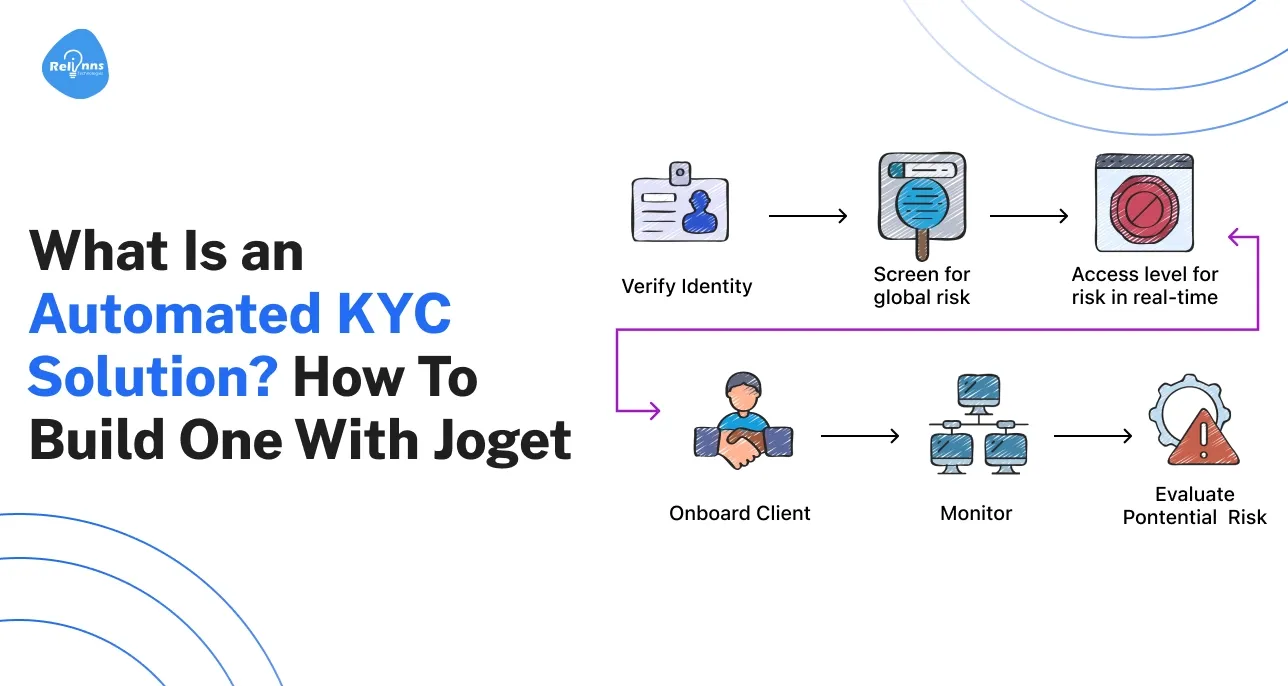
Banks and fintechs are under increasing pressure to authenticate their customers faster, more securely, and at a lower cost.
Manual KYC processes full of paperwork, delays, and errors just can’t keep up. They frustrate customers, waste time, and expose firms to compliance risks.
This is where an automated KYC solution comes in.
Using OCR, biometrics, and real-time database checks, businesses can verify identities in minutes, eliminating the need for manual input. As digital onboarding becomes a competitive edge, KYC automation for banks is no longer optional.
In this blog, you’ll learn.
- What automated KYC means and why it matters
- How it works in simple steps
- What key features and benefits does it deliver
- How Joget + Relinns helps you build it
- Common challenges and how to solve them
Whether you’re a digital bank, insurance firm, crypto exchange, or telecom provider, this blog will help you simplify identity verification and stay fully compliant.
Let’s get started.
What is an Automated KYC solution?
An automated KYC solution is a digital system that verifies customer identity using AI, OCR, and databases. It replaces manual checks with faster, accurate, and secure onboarding for businesses.
These solutions reduce fraud, ensure compliance, and improve customer experience. By automating document verification and data matching, businesses save time, cut costs, and meet regulatory requirements without slowing down user onboarding.
Why is an Automated KYC solution critical today?
As digital financial services grow, so does the risk of fraud, identity theft, and regulatory penalties.
Know Your Customer (KYC) processes were designed to prevent such risks, but manual methods can’t scale. Paper-based onboarding is slow, costly, and vulnerable to human error.
That’s why banks and fintechs are turning to automated KYC solutions.
Here’s why this shift matters
- Strict regulations, such as AML, FATF, and GDPR, now require accurate and ongoing identity checks.
- Manual KYC costs commercial banks over $175 million annually in compliance overhead.
- Customer expectations have changed—delays during onboarding can result in a 67% customer drop-off.
- Digital adoption is growing, and fintech and banking apps need real-time, remote identity verification.
- Regulatory fines exceed $27 billion due to poor KYC and sanctions screening failures.
Manual processes can’t keep pace with this pressure. But automation changes the game.
With OCR, biometrics, and database integration, identity verification becomes dramatically faster and more accurate. It reduces manual errors, ensures consistency across workflows, and logs all steps for audit readiness.
For any institution handling high-volume onboarding, this means increased confidence, reduced risk, and a better user experience.
How does an Automated KYC Solution work?
Automated KYC streamlines customer onboarding by digitizing identity verification tasks that would otherwise require manual review. By utilizing OCR, biometrics, and integrated APIs, this system reduces approval time and human effort.
In this section, we break down how a standard automated KYC solution functions step by step across real-world digital banking and fintech workflows.
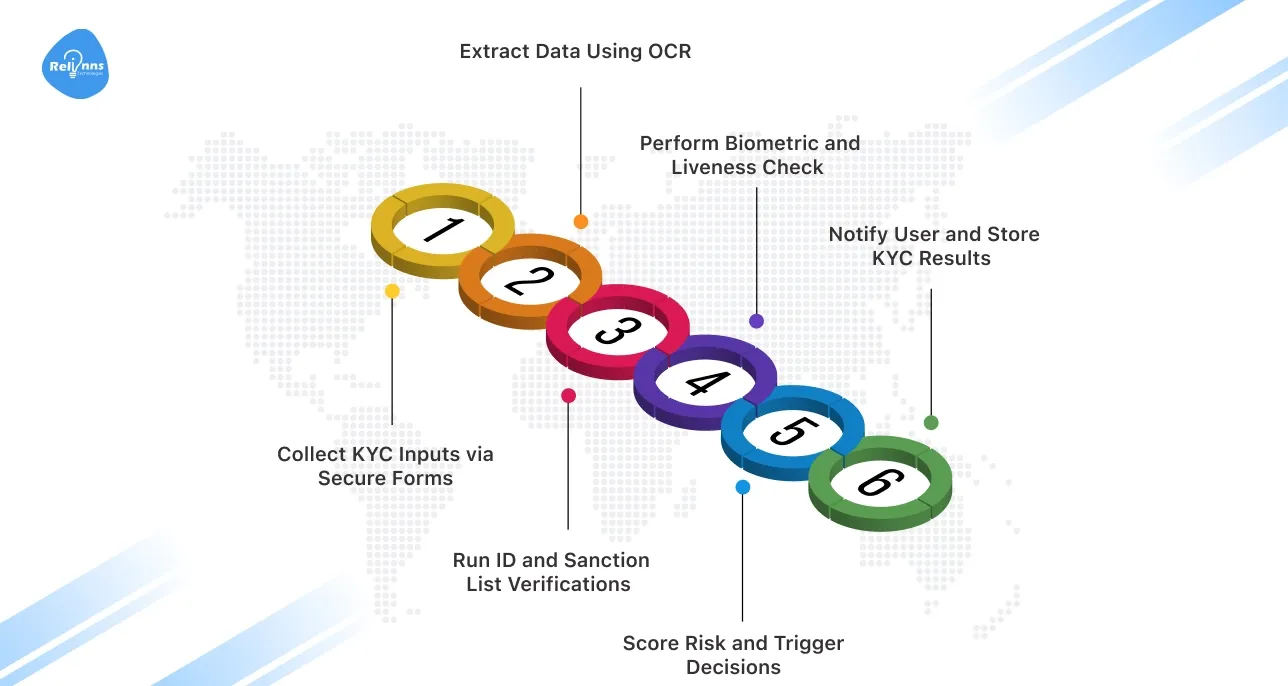
Step 1: Collect KYC inputs via secure forms
A robust automated KYC solution starts with seamless and secure data collection. Customers must be able to upload identity documents and personal information easily through mobile-friendly forms.
Using Joget, you can design structured input forms that guide users step-by-step while enforcing real-time validation and compliance standards.
- Design responsive forms that support all device types, enabling users to upload ID documents and fill in details without drop-off.
- Add validation logic to catch missing files, blurry uploads, or incomplete personal information before submission.
- Use Joget’s drag-and-drop builder to quickly build and customize forms to match your organization’s compliance needs.
Clean, structured input sets the foundation for all downstream steps, from OCR to facial matching, ensuring your system operates more efficiently with fewer manual interventions.
Step 2: Extract data using OCR
Once documents are submitted, the next step in an automated KYC solution is transforming those files into machine-readable data. This is where Optical Character Recognition (OCR) plays a critical role.
Joget can seamlessly integrate with leading OCR APIs to automate this stage within its workflow. The system can recognize passports, ID cards, utility bills, and other document types, ensuring a consistent data structure across use cases.
- Use OCR to extract key fields, such as full name, birth date, document number, and expiration date, from uploaded IDs.
- Integrate Joget with OCR APIs to automate data recognition directly within your KYC workflow, eliminating the need for custom code.
- Ensure formatting consistency by standardizing how OCR outputs are stored and used across screening and decision modules.
This is one of the most apparent automated KYC benefits, eliminating delays and increasing accuracy before identity verification even begins.
Step 3: Run ID and sanction list verifications
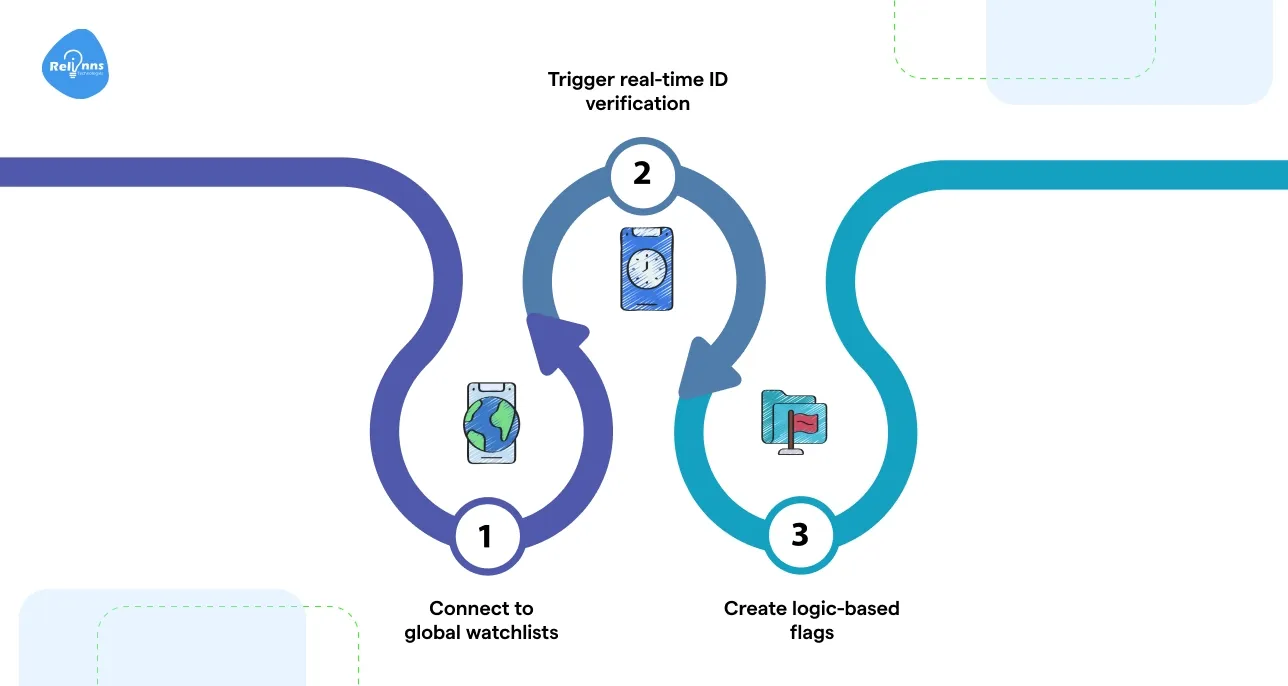
After extracting user data, an effective automated KYC solution must verify its legitimacy by cross-referencing trusted global databases. This step verifies whether the identity is genuine, active, and not associated with fraud, terrorism, or financial crimes.
Joget supports easy integration with external verification services and APIs such as OFAC, Interpol, UN Sanctions, or politically exposed persons (PEP) databases. With these tools, financial institutions can validate IDs automatically and flag high-risk profiles for enhanced due diligence.
- Connect to global watchlists, including OFAC, PEP, and AML registries, to identify sanctioned or high-risk users.
- Trigger real-time ID verification using Joget’s API connectors to government or third-party databases.
- Create logic-based flags that route suspicious or incomplete profiles to manual review queues for further evaluation and review.
This step lays the foundation for KYC automation in banks, ensuring regulatory compliance while preventing fraud at scale.
Step 4: Perform a biometric and liveness check
Even when documents are verified, fraud can still occur. That’s why the next step in a robust automated KYC solution involves biometric authentication and liveness detection.
With Joget, you can integrate biometric verification tools that prompt users to take a live selfie via webcam or mobile camera. These tools utilize facial recognition and motion tracking to verify whether the face is genuine, dynamic, and consistent with the ID image.
- Use facial recognition to compare the live image with the ID photo and confirm visual identity.
- Enable liveness detection to detect static images, deepfakes, or fraudulent replays during verification.
- Integrate biometric APIs with Joget workflows to automate risk scoring and escalate mismatches.
This biometric step is a key automated KYC benefit that proves presence, reduces fraud, and strengthens digital trust.
Step 5: Score risk and trigger decisions
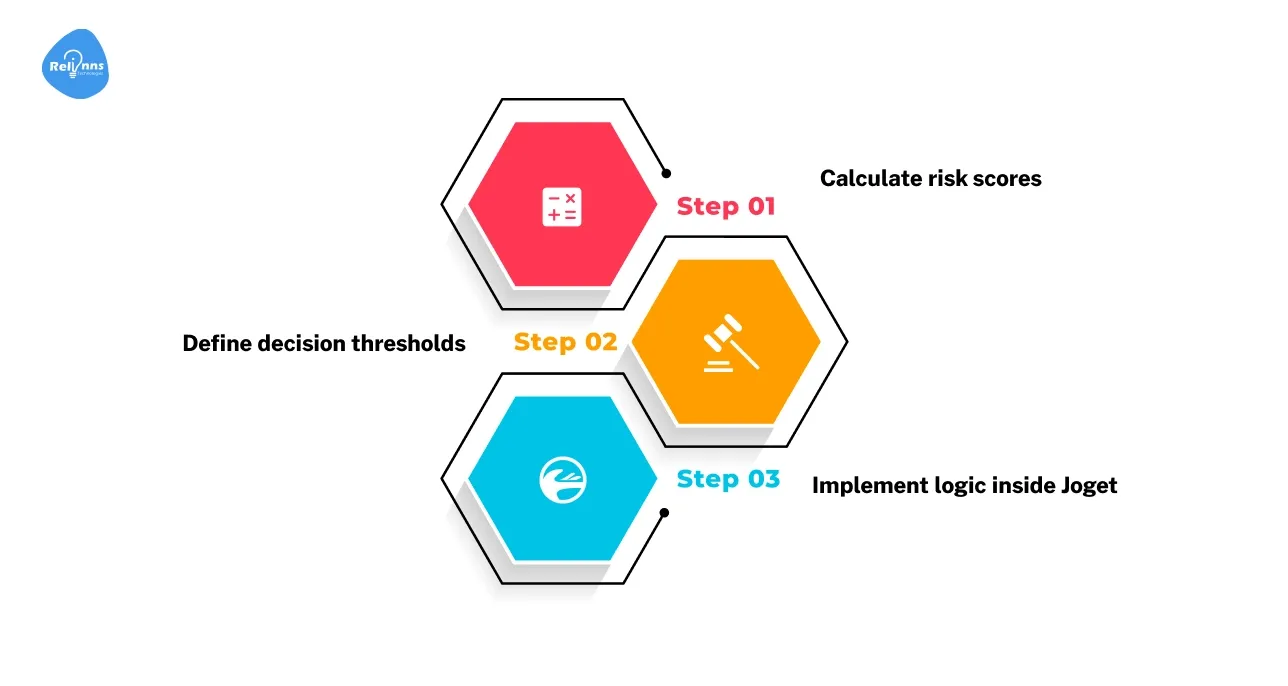
Once biometric, document, and database checks are complete, an intelligent automated KYC solution must assess the onboarding risk. This is where scoring engines come into play, evaluating the results from earlier steps and generating a risk profile for each user.
Joget makes it easy to embed custom decision logic or integrate with AI-based scoring models. You can build conditional workflows where users with low risk are auto-approved, while those with discrepancies are flagged for manual review.
- Calculate risk scores based on ID match confidence, biometric validity, and sanction check outcomes.
- Define decision thresholds that control whether a user is auto-approved, rejected, or manually escalated.
- Implement logic inside Joget to automate next steps and reduce reviewer fatigue from low-risk applications.
This stage enhances the efficiency of KYC automation for banks, making compliance scalable and eliminating bottlenecks.
Step 6: Notify user and store KYC results
The final stage in an automated KYC solution ensures that users are informed of their onboarding status and that all results are securely recorded for audits and compliance purposes. After the decision engine approves, rejects, or escalates a user, automated notifications are sent via email, SMS, or dashboard alerts.
Joget’s low-code platform enables secure data storage and the creation of audit trails with ease. It also allows teams to customize notification templates, configure alerts for compliance officers, and export structured records for reporting purposes.
- Trigger user notifications immediately upon decision via SMS, email, or in-app dashboard.
- Store KYC outputs securely, including documents, biometric scores, and screening logs with timestamps, to ensure compliance and maintain accurate records.
- Maintain audit-ready trails that meet AML, GDPR, and regulatory requirements for financial institutions.
This final step transforms your workflow into a fully compliant, transparent, and scalable automated KYC solution.
Types of verification checks in Automated KYC solutions

For an automated KYC solution to be effective, it must run multiple layers of verification beyond just document uploads.
These layers enable banks, fintechs, and other institutions to reduce fraud, enhance accuracy, and comply with regulatory frameworks such as AML, GDPR, and FATF.
Each type of check serves a unique purpose in building trust and reducing identity-related risk.
Joget supports a modular design, allowing you to plug in different verification types based on your business needs and risk profile.
Whether you're onboarding individual customers or business entities, layering these checks ensures you don’t rely on a single data point and can confidently onboard users at scale.
1. Identity and document verification
This is the foundation of every automated KYC solution. It involves analyzing government-issued IDs for authenticity and extracting key personal information using OCR and template matching.
2. Biometric match and liveness detection
Biometric verification compares a real-time selfie to the photo in the uploaded ID, while liveness detection ensures that the interaction is genuine.
This adds a high level of fraud resistance to your bank's KYC automation.
3. AML screening and sanctions list check
Regulators require businesses to screen customers against global blocklists and politically exposed persons (PEPs). This helps ensure compliance with anti-money laundering rules.
4. Address and phone number verification
To confirm a user’s residency and contact validity, systems often verify their address and phone number using utility bills, GPS, or OTP-based validation.
These layered checks make your automated KYC solution more thorough and less vulnerable to spoofing or synthetic identity fraud.
What are the key benefits of an Automated KYC solution?
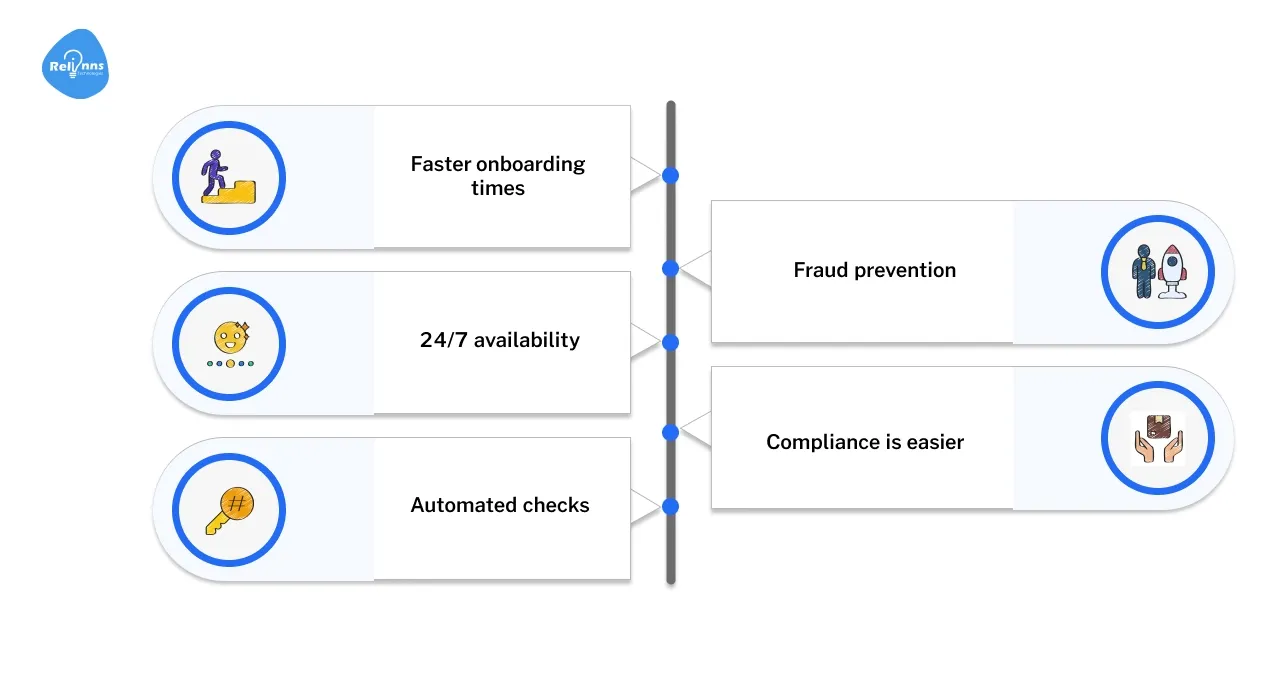
Manual KYC processes are often slow, inconsistent, and prone to human error, resulting in lost customers, compliance risks, and higher operational costs. In contrast, an automated KYC solution streamlines the entire verification journey with speed, precision, and scalability.
Whether you're a startup, a bank, or a large financial institution, automation reduces onboarding time while boosting regulatory confidence.
By leveraging tools like Joget, businesses can create customizable workflows that automate every step—from document intake to final approval—without compromising security or audit readiness.
The result? Enhanced customer experience, reduced overhead, and enhanced fraud detection.
- Faster onboarding times help reduce drop-off rates and grow customer acquisition.
- 24/7 availability means users can be verified anytime without manual oversight
- Automated checks lower human error, improving KYC accuracy and record quality.
- Fraud prevention improves as verification layers identify risky patterns instantly.
- Compliance is easier with auditable logs and ready-to-export verification results.
Each of these outcomes reflects the strategic value of implementing KYC automation for banks and regulated industries.
Top industry use cases of automated KYC solutions
The demand for an automated KYC solution is not limited to just traditional banks. A wide range of industries, from fintech to real estate, have adopted KYC automation to accelerate customer onboarding, reduce fraud, and meet global compliance standards.
These sectors share a common challenge: verifying identities at scale while minimizing friction and regulatory risk.
Let’s look at a few key use cases.
RapidLaunch Digital Bank
RapidLaunch, a fast-scaling neobank serving 100K+ users across the U.S., struggled to onboard new customers efficiently while maintaining strict compliance with KYC and AML regulations.
Challenge
Manual KYC checks led to delays in user activation, customer drop-offs, and inconsistent screening outcomes.
Their compliance team was overwhelmed by the growing volumes and unable to maintain audit readiness at scale.
With financial watchdogs tightening rules on digital banking, RapidLaunch needed a more robust and flexible onboarding process without heavy IT investment.
Solution
RapidLaunch deployed a full-stack automated KYC solution using Joget’s low-code platform. Within three weeks, the team built end-to-end onboarding workflows integrating OCR, document verification, real-time sanctions screening, and automated decision-making.
Joget’s drag-and-drop builder empowered their non-technical compliance team to customize workflows and connect third-party APIs, such as Trulioo and Sumsub, without writing code.
Results
- Cut onboarding time from 3 days to under 20 minutes.
- Reduced manual verification workload by over 60%.
- Achieved 98% data extraction accuracy using OCR and auto-formatting.
- Enabled 24/7 onboarding with zero additional staffing cost.
- Boosted regulatory confidence with fully auditable KYC logs.
Joget’s low-code flexibility delivered tangible, measurable automated KYC benefits while keeping costs low and compliance high.
Crypto Exchange – BlockNova
BlockNova, a mid-sized cryptocurrency exchange based in Singapore, faced mounting regulatory pressure to implement secure, auditable, and real-time user verification workflows to comply with regional KYC/AML mandates.
Challenge
Manual KYC workflows resulted in inconsistent identity checks, delayed trading access for new users, and an increased risk of fraud. Their compliance team struggled to keep up with changes to PEP and sanction lists across various jurisdictions.
The existing process was inefficient and couldn’t scale with their rising user base.
Solution
BlockNova integrated Joget’s low-code platform to build an automated KYC solution that included document verification, liveness checks, real-time sanction screening, and automated approval logic.
Joget enabled the exchange to plug in identity verification APIs and customize decision flows using drag-and-drop tools without waiting on developers.
Results
- Decreased onboarding rejection rate by 22% through real-time field validations.
- Enabled full compliance with MAS AML laws and FATF guidelines.
- Reduced fraud attempts with multi-layered biometric and database checks.
- Scaled from 5,000 to 60,000 verified users in 6 months.
- Cut manual KYC case escalations by 40% with automated routing logic.
This showcases the direct automated KYC benefits Joget brings to compliance-heavy crypto.
Insurance – MediSure Health
MediSure Health, a health insurance provider operating across five states in the U.S., faced growing claims fraud and slow customer onboarding due to outdated KYC practices.
Challenge
With thousands of new policy applications per month, MediSure’s manual KYC process created a bottleneck. Errors in document handling, delays in identity verification, and a lack of biometric validation exposed the company to compliance risks and fraud.
Customers often dropped off mid-process due to long approval times and a lack of real-time updates.
Solution
MediSure deployed a Joget-powered automated KYC solution to digitize and streamline its entire policyholder onboarding workflow. The system included document uploads with OCR, facial recognition, address verification, and built-in alerts for suspicious patterns.
Joget’s low-code visual builder helped the operations team integrate verification APIs (such as LexisNexis) and set custom risk thresholds without requiring engineering cycles.
Results
- Reduced onboarding cycle from 72 hours to under 30 minutes.
- Prevented 18% of fraudulent policy activations using multi-layered verifications.
- Increased customer satisfaction scores by 23% due to faster onboarding.
- Reduced KYC-related compliance escalations by 60%.
- Enabled internal teams to update workflows without dev support.
This illustrates how KYC automation for banks and insurers delivers real-time efficiency, enhanced fraud protection, and regulatory confidence.
How to build an Automated KYC solution with Joget?
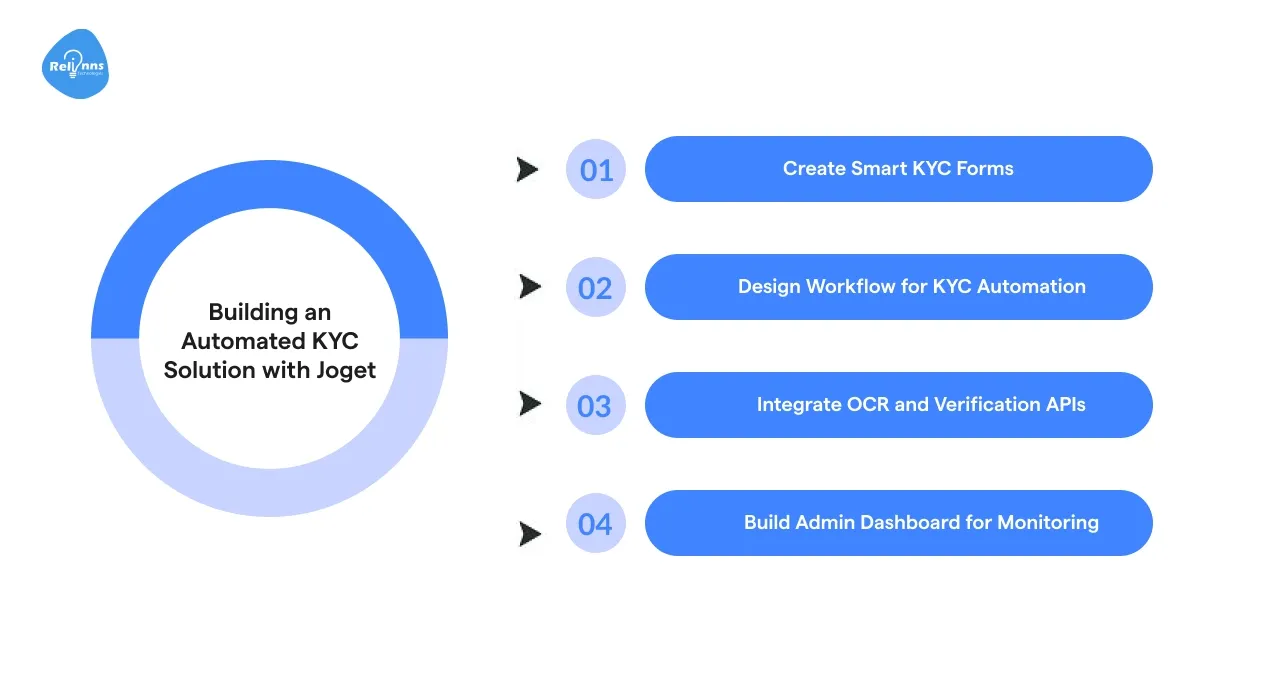 Creating an end-to-end automated KYC solution doesn’t require months of development or a large IT team, especially when you’re usingHow to a powerful low-code platform like Joget.
Creating an end-to-end automated KYC solution doesn’t require months of development or a large IT team, especially when you’re usingHow to a powerful low-code platform like Joget.
With its drag-and-drop components, visual workflow editor, and seamless API integration, Joget enables businesses to build KYC workflows that are fast, scalable, and fully compliant.
You can design complex identity verification flows using modular building blocks, making it easy to customize for fintech, crypto, insurance, and telecom use cases.
From capturing user input to screening, scoring, and approvals, every layer of the KYC process can be digitized and automated within a single platform.
Below is a breakdown of how Joget enables each layer of the KYC pipeline.
1. Create Smart KYC Forms
Design responsive web forms to collect essential user data, such as full name, address, government ID uploads, and live selfie captures.
- Include conditional logic to simplify forms for returning users.
- Capture file uploads, date of birth, gender, and document types.
- Use field validation rules to reduce incomplete or incorrect submissions.
2. Design Workflow for KYC Automation
Build visual workflows that guide users through steps such as document checks, OCR, biometrics, and manual review (if necessary).
- Automate routing for low-risk vs. high-risk applicants.
- Set up escalation logic for exceptions, such as expired IDs or mismatches, to ensure timely resolution of these issues.
- Connect verification checkpoints to different API services within seconds.
3. Integrate OCR and Verification APIs
Joget integrates seamlessly with third-party services, such as Onfido, Trulioo, or Sumsub, for OCR, document validation, and biometrics.
- Use plugin connectors or REST API modules to connect external tools.
- Extract data from uploaded IDs and match them to form inputs.
- Run automated face matching and liveness detection from inside Joget.
4. Build Admin Dashboard for Monitoring
Equip your compliance team with a live dashboard that displays the KYC pipeline status, flagged applications, risk scores, and logs.
- Enable search filters for applicants by ID, name, or risk level.
- Export results in Excel or PDF format for audits.
- Send alerts to administrators when red flags or false positives are detected.
What are the features to add when building a KYC Automation solution?
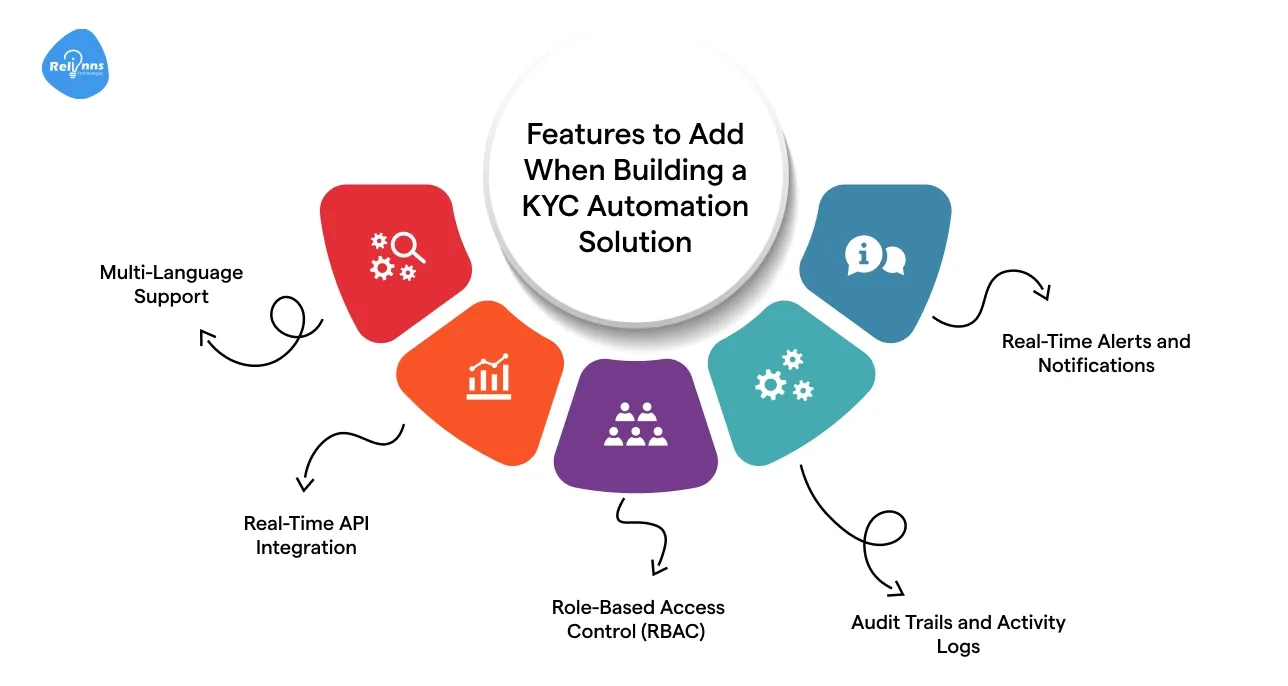
When designing your automated KYC solution on a platform like Joget, it’s essential to look beyond the core workflow.
While document uploads and verification APIs form the backbone of the system, there are critical supporting features that enhance usability, auditability, and scalability, especially in regulated industries like finance, insurance, and telecom.
Adding these components early helps reduce rework, futureproofs your setup, and provides users (and regulators) with a smoother experience.
Joget’s flexibility allows teams to incorporate these without writing extensive code or modifying backend systems.
Here are five essential features to include when building your KYC automation workflow.
1. Multi-Language Support
Support for multiple languages improves accessibility and regulatory inclusion, especially in regions with diverse populations.
- Offer dropdowns for English, Spanish, Hindi, and other languages during the onboarding process.
- Use Joget's i18n module for easy localization of labels and messages.
- Ensure validation messages, tooltips, and alerts reflect the selected language.
2. Real-Time API Integration
APIs allow your solution to sync instantly with verification providers, databases, and risk scoring engines.
- Call OCR and biometric services as soon as users upload documents.
- Pull address verification and phone data from trusted third-party APIs.
- Log API responses in the backend to meet compliance and traceability needs.
3. Role-Based Access Control (RBAC)
Limit access to sensitive data based on user roles, such as admin, reviewer, or auditor.
- Configure access rules so that reviewers see only their assigned cases.
- Block edit access for finalized KYC decisions to preserve audit integrity.
- Log role-based actions to strengthen internal governance protocols.
4. Audit Trails and Activity Logs
Joget allows you to log every event—from form submissions to API failures—to ensure full traceability.
- Automatically timestamp each step taken in the verification flow.
- Export logs to CSV or PDF for audit readiness.
- Highlight inconsistencies or skipped steps with rule-based flags.
5. Real-Time Alerts and Notifications
Keep users informed and admins in control with configurable notification workflows.
- Notify customers when KYC fails or extra documentation is needed.
- Alert compliance officers when a high-risk user is flagged.
- Use in-app notifications, emails, or SMS depending on urgency.
These features not only enhance the automated KYC benefits, but also ensure compliance, operational visibility, and a better end-user experience.
What are the common challenges in KYC Automation?
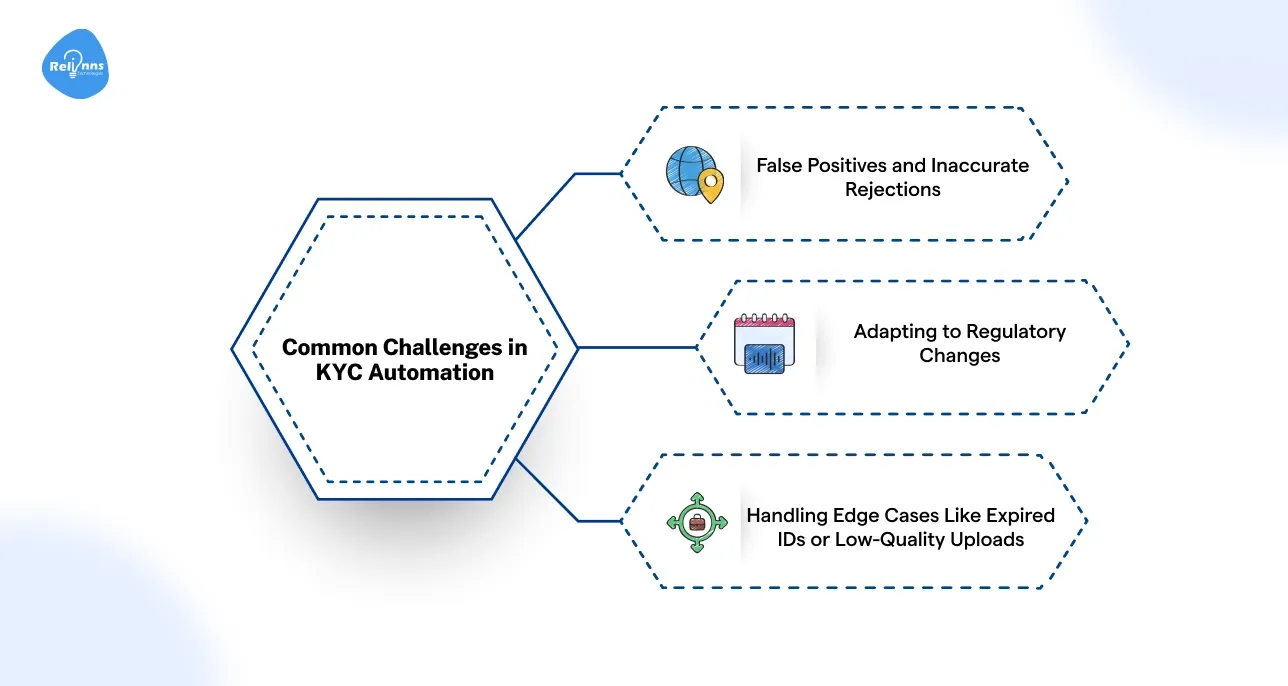
Even the best-built automated KYC solutions can encounter hurdles, especially when dealing with edge cases, evolving regulations, or real-world data quality issues.
While automation removes much of the manual friction, it also introduces new layers of complexity, such as integrating APIs, validating image quality, and managing false positives.
To ensure your KYC automation system performs reliably, it's critical to plan for these common obstacles from day one. Joget makes it easier to manage these issues with its modular design and visual debugging capabilities.
Let’s explore the typical challenges and how to handle them efficiently.
1. False Positives and Inaccurate Rejections
Automated systems sometimes incorrectly reject valid documents or flag users due to mismatched data or blurry scans.
Solutions
- Implement confidence thresholds in OCR and facial matching APIs to enhance accuracy.
- Allow manual override with reviewer notes for flagged submissions.
- Utilize Joget’s decision branching to route edge cases to the relevant compliance teams.
2. Adapting to Regulatory Changes
KYC regulations vary by country and are subject to frequent updates. Staying compliant requires your system to be flexible and updatable.
Solutions
- Configure workflows with editable rules that non-dev teams can change.
- Maintain a regulatory calendar to track AML/KYC updates across regions.
- Leverage Joget’s plugin architecture to swap or update API integrations easily.
3. Handling edge cases like expired IDs or low-quality uploads
Users may upload images that are too dark, low resolution, or expired.
Solutions
- Add built-in validation for document expiry dates at the upload stage.
- Use auto-enhancement APIs or flag poor images for manual review.
- Provide clear retry instructions in-app with screenshots or tooltips.
By proactively addressing these issues, businesses can maintain KYC integrity while offering a smoother onboarding experience.
With Joget, these fixes are fast to implement, ensuring the system stays reliable and technical delays or false alarms don’t dilute the automated KYC benefits.
Automated KYC vs eKYC vs Digital KYC: What’s the difference?
With the growing need for fast and secure customer onboarding, terms like automated KYC solution, eKYC, and digital KYC are often used interchangeably.
However, they refer to distinct approaches that differ in terms of how much of the process is automated, where the data is handled, and how scalable the system is.
Understanding these distinctions is crucial for selecting the ideal solution for your business. A small lender may find eKYC sufficient, while a large fintech platform aiming to onboard thousands of users per week may require fully automated workflows.
Here's a breakdown of the three KYC models and their fit.
Feature/Factor | Digital KYC | eKYC | Automated KYC Solution |
| Automation Level | Low (mostly manual verification) | Medium (semi-automated via backend tools) | High (end-to-end automated workflows) |
| Setup Time | Fast, but prone to manual delays | Moderate | Longer upfront, faster in the long run |
| Ideal For | Small agencies or one-time checks | Banks, NBFCs, telecom | Fintech, insurance, crypto, scaling ops |
| API Integration | Usually absent | Backend APIs only | Full API-based architecture |
| User Experience | Varies; often slow | Moderate | Seamless, fast, real-time onboarding |
| Compliance Readiness | Manual reports | Audit trails via backend | Built-in logs, version control, alerts |
| Scalability | Low | Medium | High, easily handles large volumes |
For modern enterprises seeking to scale securely, a fully automated KYC solution is often the better long-term investment.
It minimizes human error, accelerates verification, and ensures regulatory consistency across jurisdictions—all while providing a smoother user experience.
Future Trends in KYC Automation
KYC is transforming rapidly. To remain ahead, businesses must adopt forward-thinking tools and processes. Below are six future trends shaping the next wave of automated KYC solutions.
- AI-Powered Risk Detection: Use of AI and LLMs to detect fraud and anomalies faster.
- Self-Sovereign Identity (SSI): Verified IDs owned and reused by users across platforms.
- Voice and Video Biometrics: Enhanced identity checks using behavioral and facial patterns.
- No-Code Compliance Tools: Platforms like Joget allow rapid deployment of KYC workflows.
- RegTech API Ecosystems: Easier plug-and-play integration with compliance and watchlist services.
- Hyper-Personalized Verification: Real-time customization of KYC paths based on user behavior.
These innovations are paving the way for more secure, scalable, and user-centric KYC automation for banks and other industries.
Final Thoughts:
In today’s regulatory and digital landscape, relying on manual or semi-automated processes is simply insufficient for scaling. Whether you're in fintech, insurance, banking, or cryptocurrency, the costs of onboarding delays, verification errors, and compliance gaps can be substantial.
An automated KYC solution not only reduces those risks, but it also unlocks speed, security, and more intelligent decision-making.
The benefits are clear: faster verification, lower operational overhead, better fraud prevention, and stronger audit trails. From a compliance standpoint, automation ensures consistency across all users, regions, and updates something even the best manual processes struggle to achieve.
Platforms like Joget enable compliance and operations teams to build these solutions visually, with no prior coding experience. You can update workflows, add API integrations, and scale to new markets all without waiting months for development cycles.
Why startups and enterprises choose Relinns Technologies
If you're looking to implement KYC automation with minimal hassle and rapid results, Relinns Technologies is your ideal partner for low-code solutions. Their team specializes in building secure, scalable identity verification flows using Joget, tailored to your industry needs.
- A 70% cost savings achieved by outsourcing developers to low-code agencies in countries such as India or Vietnam.
- 58% of startups use low-code platforms to launch MVPs within 8–12 weeks.
- 87% of companies using Agile report faster delivery and lower development waste.
- 60% of SaaS companies offer white-label apps to generate passive B2B revenue.
- 72% of agencies provide both product and resource white labeling to meet scaling demands flexibly.
Contact Relinns to help you go live faster with confidence, compliance, and control.
Frequently Asked Questions (FAQs)
What is the cost of an automated KYC solution?
Costs vary by volume, API usage, and licensing for an automated KYC solution. Startups pay a few cents per verification; banks budget $500,000 yearly.
How long does it typically take for banks to deploy KYC automation?
Low-code solutions like Joget enable the launch of workflows within weeks; rollouts, including integrations and training, are typically completed in three to six months.
Can an automated KYC solution integrate with legacy core banking systems?
Yes. REST or SOAP connectors bridge Joget workflows to mainframes or Oracle cores, synchronizing customer data without requiring infrastructure changes.
How does an automated KYC solution address GDPR and data privacy requirements?
Platforms enforce encryption at rest, role‑based access, data minimization, consent capture, and deletion schedules aligned with privacy laws.
What metrics show the ROI of KYC automation for banks?
Track onboarding reduction, verification cost per user, compliance fines avoided, customer drop‑off decreases, and revenue uplift from faster account activation.
Should automated KYC solutions be deployed on‑premises or in the cloud?
Cloud offers rapid scaling and lower maintenance, while on-premises solutions provide tighter data control. Hybrid models strike a balance between latency, sovereignty, and compliance needs.


